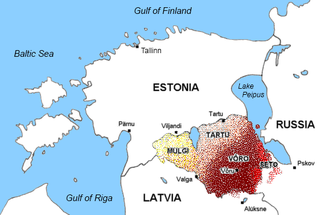An editor has performed a search and found that
sufficient sources exist to establish the subject's
notability. (July 2024) |
This article needs additional citations for
verification. (July 2024) |
| Tartu | |
|---|---|
| tartu kiil tarto kiil | |
| Native to | Estonia |
| Region | Tartumaa |
Native speakers | 17,310 (2021 census) [1] |
Uralic
| |
Standard forms |
|
| Dialects |
|
| Latin script | |
| Language codes | |
| ISO 639-3 | – |

Linguistic map of southern Estonia. Tartu is found north of the
Võro-speaking area. | |
The Tartu language ( Estonian: tartu keel) is a variety of South Estonian spoken in Estonia, near the city of Tartu. It bears similarities to Mulgi, particularly the Tarvastu and Helme varieties. It has historically, along with northern Võro, been the basis for the South Estonian literary language. [2] [3]

In the 2011 Estonian census, 4109 people were reported to be speaking the Tartu language, and in the 2021 census 17310 native speakers reported to have spoken the language. [1]
It reached its peak in the 17th century and declined until the 2000s. Its speaker numbers have been increasing ever since, but the majority of speakers are aging, and there is a lack of media in Tartu. Revival movements for Tartu have not been as strong as those for the Seto, Mulgi and Võro languages.
Jakob Hurt's collection "Eesti mõtteloo" contains his sermons in the Rõngu dialect of Tartu. In modern literature, Mats Traat was the main user of Tartu.
- ^ a b "RL21446: POPULATION WITH ESTONIAN AS THEIR MOTHER TONGUE BY ABILITY TO SPEAK A DIALECT, AGE GROUP, SEX, AND PLACE OF RESIDENCE (ADMINISTRATIVE UNIT), 31 DECEMBER 2021". PxWeb. Retrieved 2024-07-21.
- ^ Erelt, Mati, ed. (2007). Estonian language (PDF). Linguistica Uralica. Supplementary series (2nd ed.). Tallinn: Estonian Academy Publishers. ISBN 978-9985-50-399-7. OCLC 321053986.
- ^ Velsker 2015.
- Velsker, Mart (2015-07-07). "South Estonian Literature: A New Phenomenon with a Centuries-long History". Interlitteraria. 20 (1): 115. doi: 10.12697/IL.2015.20.1.9. ISSN 2228-4729.
An editor has performed a search and found that
sufficient sources exist to establish the subject's
notability. (July 2024) |
This article needs additional citations for
verification. (July 2024) |
| Tartu | |
|---|---|
| tartu kiil tarto kiil | |
| Native to | Estonia |
| Region | Tartumaa |
Native speakers | 17,310 (2021 census) [1] |
Uralic
| |
Standard forms |
|
| Dialects |
|
| Latin script | |
| Language codes | |
| ISO 639-3 | – |

Linguistic map of southern Estonia. Tartu is found north of the
Võro-speaking area. | |
The Tartu language ( Estonian: tartu keel) is a variety of South Estonian spoken in Estonia, near the city of Tartu. It bears similarities to Mulgi, particularly the Tarvastu and Helme varieties. It has historically, along with northern Võro, been the basis for the South Estonian literary language. [2] [3]

In the 2011 Estonian census, 4109 people were reported to be speaking the Tartu language, and in the 2021 census 17310 native speakers reported to have spoken the language. [1]
It reached its peak in the 17th century and declined until the 2000s. Its speaker numbers have been increasing ever since, but the majority of speakers are aging, and there is a lack of media in Tartu. Revival movements for Tartu have not been as strong as those for the Seto, Mulgi and Võro languages.
Jakob Hurt's collection "Eesti mõtteloo" contains his sermons in the Rõngu dialect of Tartu. In modern literature, Mats Traat was the main user of Tartu.
- ^ a b "RL21446: POPULATION WITH ESTONIAN AS THEIR MOTHER TONGUE BY ABILITY TO SPEAK A DIALECT, AGE GROUP, SEX, AND PLACE OF RESIDENCE (ADMINISTRATIVE UNIT), 31 DECEMBER 2021". PxWeb. Retrieved 2024-07-21.
- ^ Erelt, Mati, ed. (2007). Estonian language (PDF). Linguistica Uralica. Supplementary series (2nd ed.). Tallinn: Estonian Academy Publishers. ISBN 978-9985-50-399-7. OCLC 321053986.
- ^ Velsker 2015.
- Velsker, Mart (2015-07-07). "South Estonian Literature: A New Phenomenon with a Centuries-long History". Interlitteraria. 20 (1): 115. doi: 10.12697/IL.2015.20.1.9. ISSN 2228-4729.
